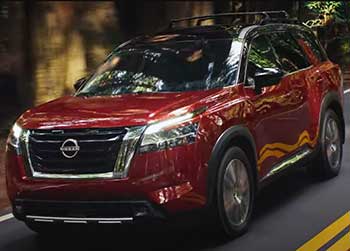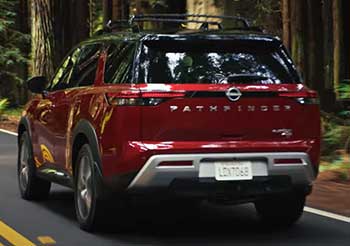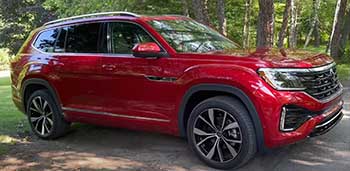
As a car enthusiast and a parent juggling family life, I’ve spent countless hours researching SUVs that balance practicality, performance, and comfort.
The 2025 Nissan Pathfinder and Volkswagen Atlas caught my attention for their three-row seating and family-friendly features.
In this article, I’ll share my firsthand insights, comparing these midsize SUVs head-to-head to help you decide which one suits your lifestyle.
From towing capacity to interior space, safety features, and driving dynamics, I’ll break down the pros, cons, and key differences to guide your choice.
Comparison Table
| Feature | Nissan Pathfinder | Volkswagen Atlas |
|---|---|---|
| Starting MSRP | $37,790 | $39,625 |
| Engine | 3.5L V6 (284 hp, 259 lb-ft) | 2.0L Turbo 4-cylinder (269 hp, 273 lb-ft) |
| Towing Capacity | 6,000 lbs | 5,000 lbs |
| Fuel Economy (Combined) | 23 mpg | 22 mpg |
| Cargo Space (Behind 3rd Row) | 16.6 cu ft | 20.6 cu ft |
| Max Cargo Space | 80.5 cu ft | 96.8 cu ft |
| Seating Capacity | Up to 8 | Up to 7 |
| NHTSA Safety Rating | 5 stars | 5 stars |
| IIHS Rating | Top Safety Pick+ | Top Safety Pick |
| Infotainment Screen | 9-inch (standard) | 12-inch (higher trims) |
| AWD System | Available, 7 drive modes | 4Motion, selectable modes |
My Experience With The Nissan Pathfinder
I climbed into the 2025 Nissan Pathfinder with high expectations, and it didn’t disappoint. The rugged, boxy design gave it a commanding presence on the road, and the interior felt like a step up from its predecessors.
Driving through city streets and winding country roads, I found the Pathfinder’s 3.5-liter V6 engine smooth and responsive, delivering 284 horsepower. Its nine-speed automatic transmission shifted seamlessly, making highway cruising effortless.
The cabin was quiet, and the available ProPilot Assist system—a semi-autonomous driving aid—kept me centered in my lane during long drives, reducing fatigue.
The Pathfinder’s interior is practical for families. With seating for up to eight, it’s a great fit for larger households. The second-row bench seat was spacious enough for my kids’ car seats, though the third row felt a bit tight for adults.
Cargo space behind the third row (16.6 cubic feet) handled groceries and sports gear, but I wished for a bit more room. Off-road, the Pathfinder’s seven drive modes, including sand and mud/rut, gave me confidence on uneven terrain. Overall, it’s a versatile SUV that balances daily commuting with weekend adventures.
Pros Of The Nissan Pathfinder
- Powerful V6 Engine: The 3.5-liter V6 delivers 284 horsepower, offering robust acceleration for merging onto highways or tackling steep inclines.
- Impressive Towing Capacity: With a 6,000-pound towing limit, the Pathfinder easily hauls trailers or boats, outpacing the Atlas by 1,000 pounds.
- Advanced Safety Features: Standard features like Automatic Emergency Braking, Blind-Spot Warning, and a driver alert monitor provide peace of mind for family driving.
- Top Safety Ratings: The Pathfinder earns a 5-star NHTSA rating and IIHS Top Safety Pick+ for 2025, thanks to its robust crash test performance.
- Versatile Drive Modes: Seven drive modes, including off-road settings, make it adaptable for various terrains, from city streets to muddy trails.
- Affordable Starting Price: At $37,790, it undercuts the Atlas, offering more value for budget-conscious buyers.
- Comprehensive Warranty: Nissan’s 5-year/60,000-mile powertrain warranty and unlimited-mile corrosion coverage beat the Atlas in longevity.
The Pathfinder’s strengths shine for families needing a reliable, powerful SUV. Its towing capacity is a standout, perfect for those who tow campers or boats. The V6 engine feels peppy, and the nine-speed transmission ensures smooth shifts. Safety is a major plus—features like knee airbags and a front seat center airbag (on Platinum trims) add layers of protection.
I appreciated the intuitive infotainment system, with a 9-inch touchscreen and standard Apple CarPlay/Android Auto. For off-road enthusiasts, the drive modes make it a capable choice, though it’s not a hardcore off-roader. The lower starting price and strong warranty make it a practical pick.
Read more: My Thoughts on Honda Odyssey Vs. Subaru Ascent
Cons Of The Nissan Pathfinder

- Limited Cargo Space: With only 16.6 cubic feet behind the third row, it lags behind the Atlas, making it less ideal for heavy packers.
- Cramped Third Row: The third row’s 28 inches of legroom feels tight for adults, limiting its appeal for long trips with older passengers.
- Fuel Economy: At 23 mpg combined, it’s slightly better than the Atlas but trails competitors like the Honda Pilot (25 mpg combined).
- Basic Interior Materials: While functional, some plastics in the lower trims feel less premium compared to the Atlas’s softer touches.
- No Hybrid Option: Unlike some rivals, the Pathfinder lacks a hybrid powertrain, which could appeal to eco-conscious buyers.
- Infotainment Size: The 9-inch touchscreen is smaller than the Atlas’s available 12-inch display, which feels more modern.
- Ride Firmness: The suspension can feel stiff over rough roads, especially in the Rock Creek trim, compared to the Atlas’s softer ride.
While I enjoyed driving the Pathfinder, its cargo space was a letdown. Packing for a family road trip required creative Tetris skills, especially with the third row up. The third row’s tight legroom meant my taller friends weren’t comfortable on longer drives. Fuel economy, while decent, doesn’t match class leaders, and the lack of a hybrid option feels like a missed opportunity.
The interior, while practical, doesn’t exude luxury in base trims, and the smaller infotainment screen felt a bit dated next to the Atlas’s larger display. The ride, while controlled, sometimes felt harsher than I’d like on bumpy roads.
Maintenance Tips For The Nissan Pathfinder
- Regular Oil Changes: Change the oil every 5,000-7,500 miles to keep the V6 engine running smoothly; use synthetic oil for better longevity.
- Tire Rotations: Rotate tires every 6,000 miles to ensure even wear, especially if you frequently use the AWD system or tow heavy loads.
- Brake Inspections: Check brake pads and rotors every 10,000 miles, as the Pathfinder’s weight and towing capacity can stress the braking system.
- Air Filter Replacement: Replace the engine and cabin air filters every 15,000 miles to maintain performance and interior air quality.
- Transmission Fluid: Flush and replace transmission fluid every 60,000 miles to preserve the nine-speed automatic’s smooth operation.
- Battery Maintenance: Test the battery annually, especially in cold climates, to avoid unexpected failures; clean terminals to prevent corrosion.
- Check Drive Modes: If using off-road modes, inspect the undercarriage for debris or damage after trips to maintain AWD system integrity.
Maintaining the Pathfinder is straightforward but crucial for its longevity. Regular oil changes keep the V6 humming, especially under towing stress. Tire rotations are a must for even wear, particularly if you’re using AWD or tackling off-road trails.
Brakes take a beating with heavy loads, so frequent inspections prevent costly repairs. Air filters impact both performance and cabin comfort, so don’t skip replacements. The transmission fluid flush is key to avoiding jerky shifts in the nine-speed. I also recommend checking the battery before winter and inspecting the undercarriage after off-road adventures to catch any issues early.
My Experience With The Volkswagen Atlas
The 2025 Volkswagen Atlas impressed me with its cavernous interior and refined ride. Its sleek, refreshed design turned heads, and the turbocharged 2.0-liter four-cylinder engine, pumping out 269 horsepower and 273 lb-ft of torque, felt punchy for daily driving.
The eight-speed automatic transmission was smooth, and the available 4Motion AWD system handled snowy roads with ease. The cabin felt upscale, with soft-touch materials and a massive 12-inch infotainment screen on higher trims that made navigation a breeze.
Inside, the Atlas is a family hauler’s dream. It seats up to seven, with generous second- and third-row legroom (37.6 and 33.7 inches, respectively). The 20.6 cubic feet of cargo space behind the third row swallowed strollers and groceries effortlessly, and folding the rear rows opened up 96.8 cubic feet.
The ride was plush, soaking up bumps better than the Pathfinder. However, its towing capacity (5,000 pounds) lagged behind, and I noticed the turbo engine wasn’t as refined under heavy acceleration. Still, the Atlas felt like a premium, spacious choice for family road trips.
Pros Of The Volkswagen Atlas

- Spacious Interior: The Atlas offers 37.6 inches of second-row legroom and 33.7 inches in the third, making it more comfortable for adults than the Pathfinder.
- Massive Cargo Space: With 20.6 cubic feet behind the third row and 96.8 cubic feet max, it’s a top choice for families needing room for gear.
- Modern Infotainment: Higher trims feature a 12-inch touchscreen with crisp graphics, outshining the Pathfinder’s 9-inch display.
- Smooth Ride Quality: The soft suspension absorbs road imperfections, offering a more comfortable ride than the Pathfinder on rough pavement.
- Advanced AWD System: The 4Motion AWD with selectable modes provides excellent traction in snow or rain, ideal for variable climates.
- Strong Resale Value: The Atlas retains 4.4% more value over five years compared to the Pathfinder, per iSeeCars data.
- Heated Features: Standard heated mirrors and available heated steering wheel enhance comfort in cold weather, unlike the Pathfinder’s limited availability.
The Atlas’s interior is its biggest selling point. I could stretch out in the second row, and even the third row accommodated adults comfortably for short trips. Cargo space was a game-changer—loading up for a weekend getaway was effortless. The 12-inch infotainment screen felt futuristic, and wireless Apple CarPlay made connectivity seamless.
The ride was smooth, almost minivan-like, which my kids appreciated on long drives. The 4Motion AWD system gave me confidence in wet conditions, and the strong resale value is a bonus for future trade-ins. Heated features added a touch of luxury in chilly weather.
Cons Of The Volkswagen Atlas
- Lower Towing Capacity: At 5,000 pounds, it trails the Pathfinder by 1,000 pounds, limiting its appeal for heavy towing.
- Weaker Reliability Rating: iSeeCars rates the Atlas at 5.7/10 for reliability, significantly lower than the Pathfinder’s 8.6/10.
- Higher Starting Price: Starting at $39,625, it’s pricier than the Pathfinder, which may strain budgets.
- Fewer Airbags: With six airbags compared to the Pathfinder’s ten, it lacks knee and front center airbags for added protection.
- No Driver Alert Monitor: Unlike the Pathfinder, the Atlas doesn’t offer a system to detect driver fatigue, a safety oversight.
- Fuel Economy: At 22 mpg combined, it’s slightly less efficient than the Pathfinder and lags behind competitors like the Kia Telluride.
- Turbo Engine Noise: The 2.0-liter turbo can sound coarse under hard acceleration, less refined than the Pathfinder’s V6.
The Atlas’s towing capacity was a letdown for me, as I occasionally haul a small trailer. Its reliability rating gave me pause—Nissan’s track record feels more reassuring. The higher starting price stung, especially since some safety features, like a driver alert monitor, aren’t included.
The six airbags felt inadequate compared to the Pathfinder’s ten, especially for a family SUV. Fuel economy was another drawback; I noticed more frequent gas station stops. The turbo engine, while torquey, sounded rough when pushed, which detracted from the premium feel. These issues made me question its long-term value.
Also read: My Thoughts on Ford Edge Vs. Hyundai Tucson
Maintenance Tips For The Volkswagen Atlas
- Oil Changes: Change synthetic oil every 7,500 miles to keep the turbocharged engine in top shape; check for leaks due to turbo stress.
- Tire Maintenance: Rotate tires every 6,000 miles and check alignment, as the Atlas’s weight can cause uneven wear, especially with AWD.
- Brake Checks: Inspect brakes every 10,000 miles, as the soft suspension can mask wear on pads and rotors during heavy use.
- Cooling System: Flush coolant every 40,000 miles to protect the turbo engine from overheating, a common issue in turbocharged vehicles.
- Air Filters: Replace engine and cabin air filters every 15,000 miles to maintain turbo performance and interior air quality.
- Battery Care: Test the battery every 12 months, particularly in cold climates, to ensure reliable starts; clean terminals regularly.
- Transmission Service: Service the eight-speed automatic every 60,000 miles to prevent sluggish shifts and maintain smooth operation.
The Atlas’s turbo engine demands diligent maintenance. Regular oil changes are critical to prevent turbo wear, and I’d check for leaks during each service. Tires wear faster on heavier SUVs, so rotations and alignments are key. Brakes can degrade subtly due to the plush ride, so frequent checks save money long-term.
The cooling system needs attention to avoid turbo-related overheating. Air filters impact both performance and comfort, so don’t skip replacements. Battery maintenance is straightforward but essential in cold weather. Servicing the transmission ensures the Atlas stays smooth and responsive, especially with the 4Motion system.
Comparison With Other Brands
- Honda Pilot: Offers 25 mpg combined and a spacious interior, but its 5,000-pound towing capacity matches the Atlas, not the Pathfinder.
- Kia Telluride: Boasts a premium interior and 5,000-pound towing, with better fuel economy (24 mpg) than both, but lacks the Pathfinder’s off-road modes.
- Toyota Highlander: Provides a hybrid option with 36 mpg combined, outpacing both in efficiency, but its 5,000-pound towing trails the Pathfinder.
- Ford Explorer: Matches the Pathfinder’s 6,000-pound towing and offers a hybrid, but its third-row space is tighter than the Atlas.
- Hyundai Palisade: Similar to the Telluride, it has a luxurious interior and 5,000-pound towing, but its AWD system is less advanced than the Atlas’s 4Motion.
- Mazda CX-9: Prioritizes sporty handling, but its 3,500-pound towing and smaller cargo space lag behind both the Pathfinder and Atlas.
- Subaru Ascent: Offers standard AWD and 5,000-pound towing, with better off-road capability than the Atlas but less cargo space than both.
The Pathfinder and Atlas compete in a crowded midsize SUV market. The Honda Pilot is a strong rival with better fuel economy but less towing power. The Kia Telluride and Hyundai Palisade offer upscale interiors and decent towing but lack the Pathfinder’s off-road versatility.
The Toyota Highlander’s hybrid option is a fuel-saver, but its towing capacity doesn’t match the Pathfinder. The Ford Explorer is a direct competitor to the Pathfinder for towing but feels less spacious than the Atlas. The Mazda CX-9 drives like a dream but falls short in utility. The Subaru Ascent is great for AWD fans but doesn’t match the Atlas’s cargo room.
Frequently Asked Questions (FAQ)
The Atlas has a lower towing capacity (5,000 pounds), weaker reliability rating (5.7/10), higher starting price ($39,625), fewer airbags, and slightly worse fuel economy (22 mpg combined) than the Pathfinder.
Yes, the Pathfinder scores an 8.6/10 reliability rating from iSeeCars, benefiting from Nissan’s robust V6 and improved post-CVT design, making it a dependable choice.
It competes with midsize SUVs like the Honda Pilot, Kia Telluride, Toyota Highlander, Ford Explorer, Hyundai Palisade, Mazda CX-9, and Subaru Ascent.
The Atlas has a lower reliability rating of 5.7/10 from iSeeCars, suggesting more potential issues compared to the Pathfinder’s stronger track record.
Conclusion: For The Nissan Pathfinder And Volkswagen Atlas
Choosing between the Nissan Pathfinder and Volkswagen Atlas depends on your priorities. If you need a powerful SUV with strong towing (6,000 pounds), top-tier safety (IIHS Top Safety Pick+), and off-road capability, the Pathfinder is your pick.
Its lower price and reliable V6 make it a value-driven choice for families. However, if you prioritize interior space, cargo capacity (96.8 cubic feet), and a plush ride, the Atlas delivers. Its modern infotainment and roomy cabin are hard to beat, though reliability and towing lag. Test-drive both to see which fits your lifestyle—you can’t go wrong, but one will feel just right.

